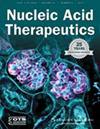反义寡核苷酸 STK-002 增加视网膜中的 OPA1 并改善常染色体显性视神经萎缩细胞的线粒体功能
IF 4.7
2区 医学
Q2 BIOCHEMISTRY & MOLECULAR BIOLOGY
引用次数: 0
摘要
常染色体显性视神经萎缩(ADOA)是一种遗传性视神经病变,最常见的病因是 OPA1 基因突变。大多数变异都会导致单倍蛋白缺乏症,患者细胞表达的 OPA1 蛋白大约只有正常水平的一半。OPA1 是线粒体 GTP 酶,对线粒体的正常功能至关重要。我们发现并鉴定了 STK-002,它是一种反义寡核苷酸 (ASO),旨在阻止 OPA1 中天然存在的替代剪接非生产性外显子的结合。STK-002 的剂量依赖性减少了该外显子的包含,并增加了人体细胞(包括 ADOA 患者来源的成纤维细胞)中的 OPA1 蛋白。ADOA 患者细胞的线粒体呼吸功能减弱,而 STK-002 治疗可改善这些细胞的线粒体呼吸功能参数。由于 STK-002 可通过野生型等位基因增加 OPA1,因此我们对野生型眼镜猴和兔子在静脉注射 STK-002 或兔子特异性代用品后的视网膜 OPA1 进行了评估。注射 ASO 4 周后,这两种动物的视网膜组织中都出现了 OPA1 蛋白增高的现象,猴子的这种现象持续了 8 周。用 ASO 治疗的猴视网膜神经节细胞中可看到 STK-002 和增强的 OPA1 免疫荧光。综合来看,这些数据支持 STK-002 作为第一种潜在的 ADOA 疾病调节疗法走向临床。本文章由计算机程序翻译,如有差异,请以英文原文为准。
Antisense Oligonucleotide STK-002 Increases OPA1 in Retina and Improves Mitochondrial Function in Autosomal Dominant Optic Atrophy Cells.
Autosomal dominant optic atrophy (ADOA) is an inherited optic neuropathy most frequently associated with OPA1 mutations. Most variants result in haploinsufficiency, and patient cells express roughly half of the normal levels of OPA1 protein. OPA1 is a mitochondrial GTPase that is essential for normal mitochondrial function. We identified and characterized STK-002, an antisense oligonucleotide (ASO) designed to prevent the incorporation of a naturally occurring alternatively spliced nonproductive exon in OPA1. STK-002 dose dependently reduced the inclusion of this exon, and increased OPA1 protein in human cells, including ADOA patient-derived fibroblasts. ADOA patient cells manifest reduced mitochondrial respiration, and treatment with STK-002 improved the parameters of mitochondrial respiratory function in these cells. Since STK-002 increases OPA1 through the wild-type allele, we assessed retinal OPA1 in wild-type cynomolgus monkeys and rabbits after intravitreal administration of STK-002 or a rabbit-specific surrogate. Increased OPA1 protein was produced in retinal tissue in both species at 4 weeks after ASO injection and persisted in monkeys at 8 weeks. STK-002 and enhanced OPA1 immunofluorescence were visualized in retinal ganglion cells of cynomolgus monkeys treated with the ASO. Cumulatively, these data support the progression of STK-002 toward the clinic as the first potential disease-modifying treatment for ADOA.
求助全文
通过发布文献求助,成功后即可免费获取论文全文。
去求助
来源期刊

Nucleic acid therapeutics
BIOCHEMISTRY & MOLECULAR BIOLOGY-CHEMISTRY, MEDICINAL
CiteScore
7.60
自引率
7.50%
发文量
47
审稿时长
>12 weeks
期刊介绍:
Nucleic Acid Therapeutics is the leading journal in its field focusing on cutting-edge basic research, therapeutic applications, and drug development using nucleic acids or related compounds to alter gene expression. The Journal examines many new approaches for using nucleic acids as therapeutic agents or in modifying nucleic acids for therapeutic purposes including: oligonucleotides, gene modification, aptamers, RNA nanoparticles, and ribozymes.
 求助内容:
求助内容: 应助结果提醒方式:
应助结果提醒方式:


